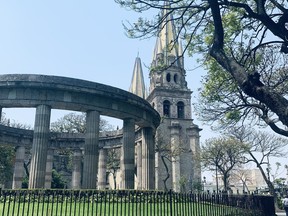Breadcrumb Links
Travel Local Travel
When you visit Guadalajara, you'll find food, flavors, and great art at every turn.
Published June 26, 2024 • Last updated 40 minutes ago • 6 minute read
To save this article, register for free here, or sign in if you have an account.
 Guadalajara's historic center is rich in neoclassical and Gothic architecture. Photo by Lynn Mitches/PNG
Guadalajara's historic center is rich in neoclassical and Gothic architecture. Photo by Lynn Mitches/PNG
Article Contents
Manuel was in a field before sunrise in the Mexican state of Jalisco, wearing jeans and long sleeves, a baseball cap and holding a sharp, rounded, sickle-like tool.
His job involves manually cutting the sharp leaves from giant blue agave plants, layer by layer, to get to the heart of the plant.
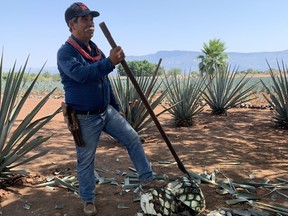 Blue agave plants, like the one Manuel photographed here, are hand-harvested, stripped to the core, and then processed into tequila in the town of Tequila, just outside Guadalajara. Photo by Lynn Miguez/PNG
Blue agave plants, like the one Manuel photographed here, are hand-harvested, stripped to the core, and then processed into tequila in the town of Tequila, just outside Guadalajara. Photo by Lynn Miguez/PNG
He works hours in this field, on the outskirts of the idyllic town of Tequila, before the sun gets too hot. No machines are used for the work, just brute force, sharpening the blades frequently, as Manuel shows us a process he's been doing for decades. In the background, rows of distinctive blue agaves stand against the striking red soil.
Ad 2
This advertisement has not loaded yet, but article continues below.
This content is available to subscribers only
Subscribe now to read the latest news from your city and across Canada.
With one account, you'll enjoy unlimited online access to articles from across Canada. Exclusive access to the Vancouver Sun ePaper, a digital version of the print edition, with the ability to share, download and comment. Enjoy insights and behind-the-scenes analysis from award-winning journalists. Support local journalists and the next generation of journalists. Daily puzzles, including the New York Times crossword.
Subscribe to unlock more articles
Subscribe now to read the latest news from your city and across Canada.
With one account, you'll enjoy unlimited online access to articles from across Canada. Exclusive access to the Vancouver Sun ePaper, a digital version of the print edition, with the ability to share, download and comment. Enjoy insights and behind-the-scenes analysis from award-winning journalists. Support local journalists and the next generation of journalists. Daily puzzles, including the New York Times crossword.
Sign up/sign in to see more articles
To continue reading, please create an account or sign in.
Access articles from across Canada with one account. Share your thoughts in the comments and join the conversation. Enjoy additional articles every month. Receive email updates from your favourite authors.
Sign in or create an account
or
Article Contents
Tons of agave are brought into El Tequileno distillery, where it is split open and the little cylindrical bitter centers removed — a step not many distillers take the time to do — before a lengthy process of steaming, fermenting, filtering and distilling results in Mexico's most famous spirit.
 Chef Paco Ruano. Photo by Maria Laura Castro Morales
Chef Paco Ruano. Photo by Maria Laura Castro Morales
It takes seven years for a blue agave tree to grow to a harvestable size, and it takes seven kilos of the plant's core to make one liter of tequila. This is not your spring break tequila, either in taste or price. It's balanced, aromatic and respectable.
This is a country of effort and care. As with many things in Mexico, attention to detail and pride in craftsmanship is the way things are done. In another Mexican town, Puerto Escondido, I had to wait twice as long for ice cream to be poured into my ice cream cone because the person making the cone wasn't satisfied the first time they made a perfect round scoop and started again. It may not have made a difference to me, but it did to her. As the slang goes, nothing is done half-heartedly here.
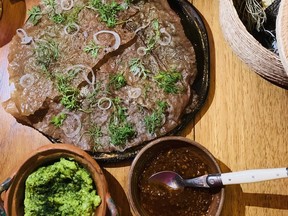 At Alcalde restaurant in Guadalajara, the cecina dried beef appetizer is paper-thin but tasty enough with the addition of guacamole and Morita chili sauce. Photo by Lynn Mitches/PNG
At Alcalde restaurant in Guadalajara, the cecina dried beef appetizer is paper-thin but tasty enough with the addition of guacamole and Morita chili sauce. Photo by Lynn Mitches/PNG
Located in Guadalajara's city center, artisanal restaurant Alcalde is sophisticated and glamorous, helmed by tattooed executive chef Paco Ruano, whose impeccable flavorings are evident in every dish. For foodies, this is a real hit.
Travel time
Thank you for your registration!
Article Contents
Ad 3
This advertisement has not loaded yet, but article continues below.
Article Contents
Ruano creates dishes with complex, layered flavors and artful presentation. His Cecina dried beef appetizer is paper-thin and melts in your mouth. It's nicely salted and enhanced by guacamole and Morita chili sauce. Mains are exciting, like pork cheek with bean sauce, chicharron and chorizo powder, or rich, tender braised veal with spicy chiliatore and bean confit. There are insect dishes, too. For the adventurous. The attention to detail and flavor construction give this place the buzz it deserves. Try his rice pudding with cinnamon ice cream, toasted chocolate and soy flakes. It's nothing like your mom used to make. Everyone should have a Ruano in their pantry.
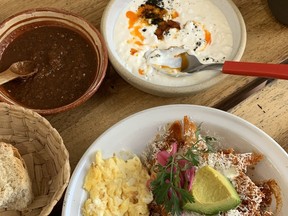 Unites restaurant in the Centenario Market in Guadalajara's colonial district serves up a breakfast bowl of tortillas topped with eggs, salsa, beans and avocado, and birote, the city's traditional bread. Photo by Lynn Mitches/PNG
Unites restaurant in the Centenario Market in Guadalajara's colonial district serves up a breakfast bowl of tortillas topped with eggs, salsa, beans and avocado, and birote, the city's traditional bread. Photo by Lynn Mitches/PNG
Guadalajara's breakfast and lunch options don't disappoint: the city's specialty and culinary staple, birote, a dense, chewy bread, is traditionally served with a casserole of cottage cheese with chili oil and salsa, ranging in spiciness from mild to rocket-launch hot.
As any Mexican will tell you, breakfast is sacred, and birote is commonly served to start the day. Want a full-on breakfast? Unites, a restaurant in Mercado Centenario in Guadalajara's colonial district, serves traditional corn tortillas stuffed with cheese and tender corn leaf sprouts, or tortilla breakfast bowls served with salsa, beans and avocado and topped with egg.
Ad 4
This advertisement has not loaded yet, but article continues below.
Article Contents
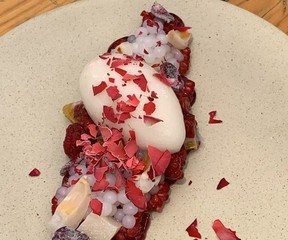 At Postoleria (postole means dessert), you can satisfy your sweet tooth even at breakfast with homemade ice cream with raspberry, lychee and fried rose petals. Photo by Lynn Mitges/PNG
At Postoleria (postole means dessert), you can satisfy your sweet tooth even at breakfast with homemade ice cream with raspberry, lychee and fried rose petals. Photo by Lynn Mitges/PNG
Located in the magical town of Tlaquepaque, Guadalajara, Casa Luna has a great atmosphere and even has live music during lunchtime. If you get the chance, be sure to try their dishes with Mexican mole. This complex sauce takes hours to fully develop its flavor and is featured all over the menu. You might not be able to fully enjoy it in one meal of the day.
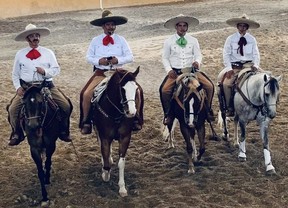 The Outlaws of Entre Charros: Charros are a unique breed of Mexican horse riders who show off their skills in shows twice a week. Photo by Lynn Mitges/PNG
The Outlaws of Entre Charros: Charros are a unique breed of Mexican horse riders who show off their skills in shows twice a week. Photo by Lynn Mitges/PNG
In a small stadium in Guadalajara, a different kind of art is on display as Jesús Mora dresses up in full uniform: chaps, spurs, a large riding sombrero and the traditional red bandana-type tie used in case of injury, the red colour being to hide the blood from a wound.
Mola is a proud third-generation charro, a cross between cowboy and rancher. Charros are like medieval knights with upgraded gear. It's a courtesy. Charros form brotherhoods, and boys start training before they turn 10, learning lassoing and horsemanship skills passed down through generations.
In one example of their equestrian prowess, Charros will gallop their horses to a full gallop, then release the reins and bring them to a spectacular sudden halt. It's a test of athleticism and trust between rider and horse, and a thrill for spectators, as the horse must stop before approaching the opposite wall of the arena. Twice a week, Mora and his Entre Charros crew show off their passion in these performances that showcase Mexican history and national pride.
Ad 5
This advertisement has not loaded yet, but article continues below.
Article Contents
 Sergio Bustamante's gallery in the Tlaquepaque neighborhood of Guadaljara displays a new collection of work each year. With beautiful displays and a Zen-like outdoor garden, this gallery is a must-see. Photo: Lynn Mitches/PNG
Sergio Bustamante's gallery in the Tlaquepaque neighborhood of Guadaljara displays a new collection of work each year. With beautiful displays and a Zen-like outdoor garden, this gallery is a must-see. Photo: Lynn Mitches/PNG
In between meals, tequila tastings, and charros performances, you'll take in the beauty of art at every turn: the neoclassical and Gothic architecture of the historic center, the spires that dot the landscape, and the giant art installations that tower over the main street.
 Guadalajara's main street is filled with intriguing, large-scale art installations, like this sculpture by José Forz. Photo by Lynn Miguez/PNG
Guadalajara's main street is filled with intriguing, large-scale art installations, like this sculpture by José Forz. Photo by Lynn Miguez/PNG
José Clemente Orozco, one of Mexico's most famous artists and muralists, lost his left hand in a firecracker accident in 1904. The darkness of his emotions seeps into the 57 murals he painted with just his right hand within two years, which decorate the vaults and walls of the Cabañas Museum in Guadalajara's Plaza Tapatia.
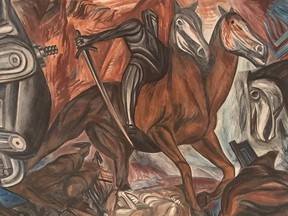 Painted in less than two years by José Clemente Orozco using only his right hand, 57 murals decorate the vaults and walls of the Cabanas Museum in Guadalajara's Plaza Tapatia. Photo by Lynn Mitches/PNG
Painted in less than two years by José Clemente Orozco using only his right hand, 57 murals decorate the vaults and walls of the Cabanas Museum in Guadalajara's Plaza Tapatia. Photo by Lynn Mitches/PNG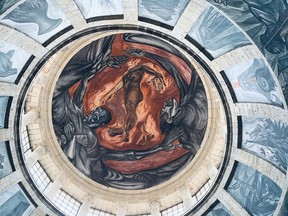 Fifty-seven murals by José Clemente Orozco decorate the vaulted ceilings and walls of the Cabanas Museum in Guadalajara's Plaza Tapatia. Photo by Lynn Mitches/PNG
Fifty-seven murals by José Clemente Orozco decorate the vaulted ceilings and walls of the Cabanas Museum in Guadalajara's Plaza Tapatia. Photo by Lynn Mitches/PNG
Orozco embodies the notion of the tortured artist. Some of his works were destroyed in the United States in the early 1900s because they were deemed immoral. Although he struggled to gain artistic recognition in his early years, his mural in Guadalajara titled “Man of Fire” has been called the Sistine Chapel of the Americas. The mural is huge, spectacularly avant-garde, and one of the works that influenced American painter Jackson Pollock.
There's a funny saying that goes, “Better dead than simple,” and it's expressed at El Parian Cantina, the largest in Latin America, which has more than a dozen restaurants and daily mariachi and dance performances where everyone makes the effort to dress up in their best attire.
Ad 6
This advertisement has not loaded yet, but article continues below.
Article Contents
This quote could be considered a Guadalajara mantra.
If you go
On May 31, Flair began direct service to Guadalajara, with one-way fares starting at $94. The service will operate twice weekly through September, increasing to three times weekly thereafter. Flair will begin operating nonstop flights from Toronto on September 13, with fares starting at $109.
The author was a Flair Airlines customer, but this article has not been read or approved by the company.
Editor's recommendation

7 misconceptions about travel journalists

Can't afford to travel? Follow the adventures of Intern Joe

Instagrammable Places in British Columbia: 10 Unique Places to Take Photos
Email:
Please support our journalism by bookmarking our website. Don't miss the stories you need to know. Bookmark VancouverSun.com and TheProvince.com and sign up for our newsletters here.
You can also support our journalism by becoming a digital subscriber: just $14 per month gets you unlimited access to The Vancouver Sun, The Province, National Post and 13 other Canadian news sites. Support us by subscribing now: The Vancouver Sun | The Province.
Article Contents
Share this article on social networks


